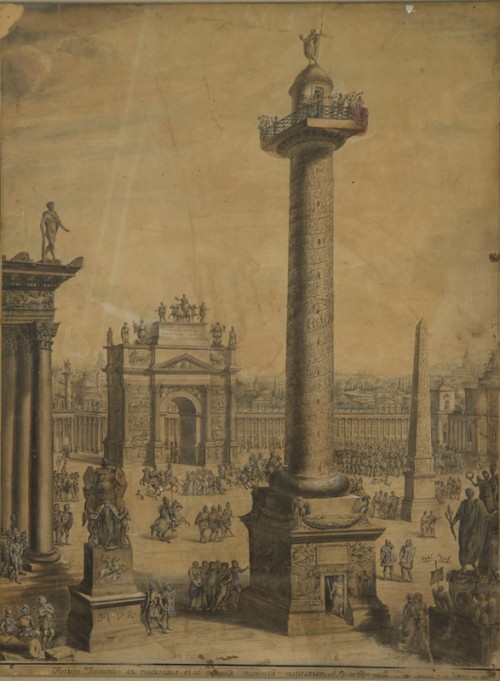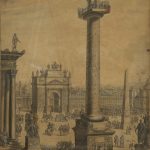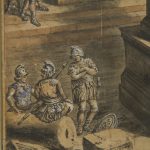11147 RECONSTRUCTION OF THE FORUM OF TRAJAN BY VINCENZO BRENNA (1745-1820) Signed and dated, Brenna Février 1810. Measurements: Height: 30″ (76 cm) Width: 22 1/2″ (57 cm)

Research
Ink, wash and gouache on paper laid onto board.
Italian architect and draughtsman Vincenzo Brenna (1747-1820), who was born in Florence to a family of stonemasons and later trained in Rome, is known predominantly for a series of architectural and interior decorative programs he produced in Poland and Russia, which played an important “role in the diffusion of international neoclassicism in Eastern Europe.”1
While studying in Rome, Brenna made his living “through the production of highly finished drawings of frescoes and monuments for the Grand Tour market.” The first mentions of the artist appear in the late 1768 when he was enlisted by English antiquary and collector Charles Townley (1737-1805) to act as a draughtsman and art agent. Brenna brokered the purchase of artworks and antiquities for his patron, and made measured drawings of classical monuments seen on their travels throughout Italy, even creating models out of pumice stone and cork.2
Brenna’s employment by Townley came to an end toward the end of the 1770s, around which time he met Count Stanislas Potocki of Poland. Potocki brought Brenna back to Poland to decorate his own palace, to build a church in Ujadzdow and to paint frescoes for the Polish king in Warsaw.3 He returned again to Rome in 1781, where he met Grand Duke Paul, future emperor of Russia, and his wife Maria Feodorovna while they were on their Grand Tour. The Grand Duke engaged Brenna as a decorative painter for Pavlovsk Palace, which was “then being built to the designs of [Charles] Cameron.”4 Shortly thereafter, however, Cameron fell out of favor with the Grand Duke and Brenna succeeded him as leading architect.
In 1783, Paul I acquired Gatchina Palace and set about with a complete redecoration before making it his official residence. Brenna was responsible for the remodeling of “spare private rooms and lavish public rooms, all in the neoclassical style.”5 When Paul’s mother, Catherine the Great, died in 1796 and he ascended the throne, Brenna once again replaced Cameron, this time at the Imperial residence of Pavlovsk Palace. Perhaps most impressive, however, was the design and construction of Saint Michael’s Palace; Brenna’s drawings were compiled into a lavish special publication and the building itself was constructed in just four years, unprecedented in this era.
Despite Brenna’s great success as an architect in Russia, little is known of his remaining years in St. Petersburg. After the termination of his professional relationship with the Imperial crown following Paul I’s death in 1802, Brenna moved to Dresden, where he lived until his own death in 1820.
During his last two decades, he did not take on any more formal architectural commissions, but continued to produce decorative works. The present drawing, signed and dated Brenna, Février 1810, is one such illustration depicting a fictive view of Trajan’s forum, which would certainly have drawn on Brenna’s memories from his time in Rome.
The Roman Emperor Trajan (r. 98 AD-115 AD) was a former general, and a popular and capable leader during the High Empire. He expanded Roman rule to distant areas, implemented programs for social welfare, and carried out ambitious building projects, the most important of which was a huge new forum built by his chief military engineer, Apollodorus of Damascus. The forum commemorated Trajan’s victories against the Dacians, the spoils of which were used to pay for its construction, and comprised a temple, two libraries devoted to Greek and Latin materials, a basilica, an equestrian statue in a large square, and a massive commemorative column.
The column of Trajan stands at 128-feet tall, and is decorated in a continuous spiral narrative frieze with reliefs that recount “Trajan’s two successful campaigns against the Dacians in more than 150 episodes in which some 2,500 figures appear.”6 The base of the column originally served as Trajan’s tomb, and a statue of the emperor initially stood at the top, but was replaced with a statue of St. Peter in the 16th century.
The column dominates the center of the present picture, and is surrounded by various buildings and monuments, most of which are inventions of the artist. Brenna creates more than a mere architectural reconstruction, and brings life to the scene by including groups of Roman soldiers and citizens, congregating throughout the forum.
Footnotes:
- Vaughan, Gerard. “Vincenzo Brenna Romanus: Architectus Et Pictor” ; Drawing from the Antique in Late Eighteenth-Century Rome.” Apollo. (1996). 37.
- Ibid., 39.
- Palmer, Allison L. Historical Dictionary of Neoclassical Art and Architecture. Lanham [Md.: Scarecrow Press, 2011. 43.
- Vaughan, 37.
- Palmer 44.
- Gardner, Helen, and Fred S. Kleiner. Gardner’s Art Through the Ages: The Western Perspective. Boston, MA: Wadsworth/Cengage Learning, 2014. 208.


Comments are closed.